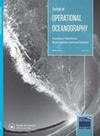海面高度的变分资料同化成区域风暴潮模式:优点和局限性
IF 2.4
3区 地球科学
Q4 METEOROLOGY & ATMOSPHERIC SCIENCES
引用次数: 5
摘要
风暴潮是由气象条件引起的沿海海平面变化。至关重要的是,它们的准确预测,以减少潜在的经济损失和生命损失。在这项研究中,我们探讨了如何有效地利用变分同化从潮汐计稀疏海平面观测可以用于业务预报在北海。考虑并评估了新的数据同化思想:一种新的最短路径方法,用于在存在海岸边界的情况下产生改进的基于距离的相关性,以及一种自适应误差协方差模型。通过从北海案例研究的同化过程中删除潮汐计的选择,验证了同化设置。这些实验显示了RMSE和相关性的广泛改善,在某些位置分别达到16厘米和0.7厘米。模拟预报实验表明,预报前24 h的RMSE提高了5 cm,具有实际应用价值。然而,超过24小时,改善很快就会消失。在大多数情况下,使用基于最短路径算法的设置与简单的欧几里得方法相比差异不大。对这一事件的分析表明,由于数据同化而得到的改进是有限的,而且持续时间相对较短。本文章由计算机程序翻译,如有差异,请以英文原文为准。
Variational data assimilation of sea surface height into a regional storm surge model: Benefits and limitations
ABSTRACT Storm surges are coastal sea-level variations caused by meteorological conditions. It is vital that they are forecasted accurately to reduce the potential for financial damage and loss of life. In this study, we investigate how effectively the variational assimilation of sparse sea level observations from tide gauges can be used for operational forecasting in the North Sea. Novel data assimilation ideas are considered and evaluated: a new shortest-path method for generating improved distance-based correlations in the presence of coastal boundaries and an adaptive error covariance model. An assimilation setup is validated by removing selections of tide gauges from the assimilation procedure for a North Sea case study. These experiments show widespread improvements in RMSE and correlations, reaching up to 16 cm and 0.7 (respectively) at some locations. Simulated forecast experiments show RMSE improvements of up to 5 cm for the first 24 h of forecasting, which is useful operationally. Beyond 24 h, improvements quickly diminish however. Using the setup based on the shortest path algorithm shows little difference when compared to a simpler Euclidean method at most locations. Analysis of this event shows that improvements due to data assimilation are bounded and relatively short lived.
求助全文
通过发布文献求助,成功后即可免费获取论文全文。
去求助
来源期刊
CiteScore
7.50
自引率
9.70%
发文量
8
审稿时长
>12 weeks
期刊介绍:
The Journal of Operational Oceanography will publish papers which examine the role of oceanography in contributing to the fields of: Numerical Weather Prediction; Development of Climatologies; Implications of Ocean Change; Ocean and Climate Forecasting; Ocean Observing Technologies; Eutrophication; Climate Assessment; Shoreline Change; Marine and Sea State Prediction; Model Development and Validation; Coastal Flooding; Reducing Public Health Risks; Short-Range Ocean Forecasting; Forces on Structures; Ocean Policy; Protecting and Restoring Ecosystem health; Controlling and Mitigating Natural Hazards; Safe and Efficient Marine Operations

 求助内容:
求助内容: 应助结果提醒方式:
应助结果提醒方式:


